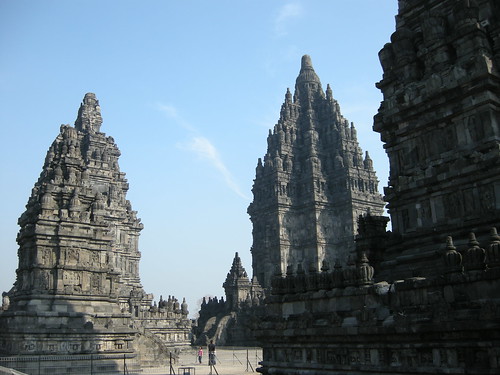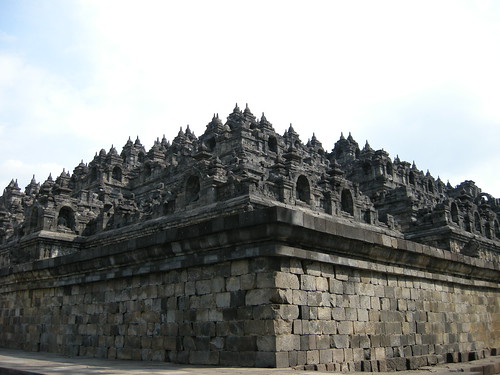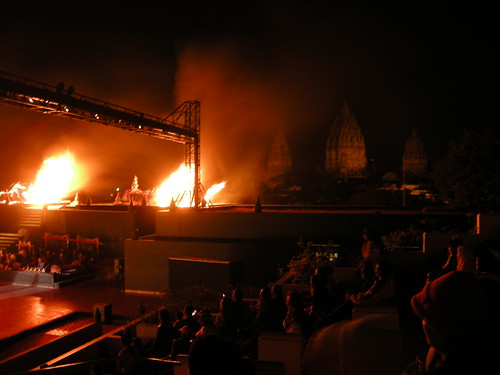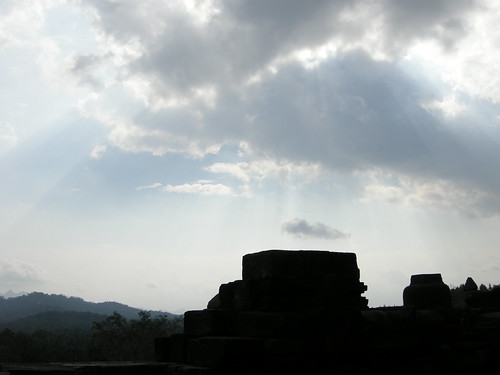
After a cramped 11-hour bus ride we arrived at Prambanan, a 9th-century Hindu temple complex just outside of Yogya. Since we got there at 7 am, there weren't many tourists, just a few locals and kids. Of course we had arranged a guided tour but my archaeologist's pride was diverting my attention so I struck off on my own about 5 seconds after our guide stomped on the stone stairs to demonstrate the site's "ancient sounds." Each of the over 200 temples of Prambanan were originally adorned with niches framing a panoply of Hindu mythological imagery, running the full gamut from sacred to profane (but mostly focusing on these two). At the perimeter of the site core there are also smaller groups of Buddhist temples featuring mostly headless seated Siddharthas and some gnarly armed guards. Overall I was quite impressed with Prambanan, and especially by the reconstruction efforts that have resulted in what I saw. Like parts of the Maya area, Central Java is a region plagued by earthquakes and volcanism; the site was discovered in (and in large part remains in) ruins.

Borobudur. This is one of the main reasons I decided to come to Indonesia, and one of the most amazing things I've ever seen. Borobudur is the largest Buddhist monument in the world, one gigantic stupa composed of nine platforms supporting an original count of 504 statues of the bodhi man (my jade Maitreya makes 505). Just a massive stone cosmogram. EVERY PANEL on EVERY SIDE of EVERY LEVEL of Borobudur is decorated with relief carving, depicting mytho/historical scenes from the life of the Buddha and a wide range of gods, demons, sinners, saints, and of course holy critters. Borobudur dramatically affected Ad Reinhardt's conception of human art-making, and though I've been preoccupied with the deep connection between images, religion, and stone for a while now, I was similarly overwhelmed. After circumambulating each level several times and pressing my hand to the Buddha's in one of the stupas on the top level for luck, I slowed down and sat stunned for a while. Just me and this guy, staring at space, letting a million thoughts and memories sift through my head and not letting myself attach to any of them.
I'm getting a little esoteric. It was not just me and him. It was we two and about a million more tourists, mostly domestic, mostly loud. I felt like part of the attraction as I got asked to pose for photos at least a dozen times by virtue of the exoticism of my skin and height. Or maybe they thought I was Nicholas Cage (one Indonesian woman said I looked like him, kind of a longshot IMO). Still, Borobudur is possibly the most amazing piece of art I've seen, and though there isn't much legitimate data on why it was made or how it was used, it nevertheless remains an ancient and timeless testament to the centrality of art in human culture. Truly a man-made mountain among mountains.

After an hour's drive back to Yogya, we checked into our hotel, exhausted. After a power nap and some vacillation I decided to join my group in heading back to Prambanan for a light dinner and some opera. That is, traditional Indonesian opera, a balletic performance of the Vedic epic the Ramayana, accompanied a gamelan orchestra. I'd heard of but never heard gamelan, it is beautiful, basically 15 people playing differently pitched bells and one lead percussionist on several variously sized drums. A lot of minor chords, minimal but powerful. And you can't beat the setting (above, yes those are the Prambanan temples).






























Sunday was a half day in Yogya itself. Historically, Yogyakarta has been a bastion of Javanese culture, maintaining its traditional hereditary sultanate even in the midst of Dutch occupation and revolution, and today you can visit the sultan's palace, which we did. But what caught my eye was the graffiti, which Yogya is equally noted for, as it is the center of Java's contemporary art scene (see the gallery above, click any pic for a larger view). While my fellow volunteers were busy batik bargaining, I spent a good three hours hoofing it miles downtown, taking in the varied styles and sophisticated design of Yogya's street art and only stopping to rest my feet for a while with some gods at a small Buddhist temple I passed along the way.

That wraps Sunday up. I could write more, but I've already spent most of today uploading 150 photos (of the over 700 I took over the weekend) and formatting this post, and it's almost dark. Next time I'll talk about marriage and birth. Until then, let the sun hit ya, I'll hit you back soon.
Josh
1 comment:
yo, if you visit that museum in the borobudur complex (the listed it lonelyplanet), they have this miniature of the temple which can be pulled out part by part, and you'll see how awesome is that those old people (with the help of aliens of course) work with stone.
there's a hidden relief on the lowest terace which refused to be shown by the budist. but the museum have it all in photographs.
the main stupa have this unfinished budha statue (the fingers and toe were not carved yet)and a gold jewelery (or something precious like that). the statue is in the museum. the gold was... wel... in dutch (or that what the museum dude told me)
there's also this HUGE budha head in the museum but it wasn't belong to borobudur anyway.
if you got some time off, i'd recomend you to go to the National Museum in Jakarta, they have a cool colection about stuffs like this. the gem stone section was REALLY COOL!!!! they have this origininal Ken Dedes statue which just recently gave back by the dutch gov.
cool pics josh!!
Post a Comment